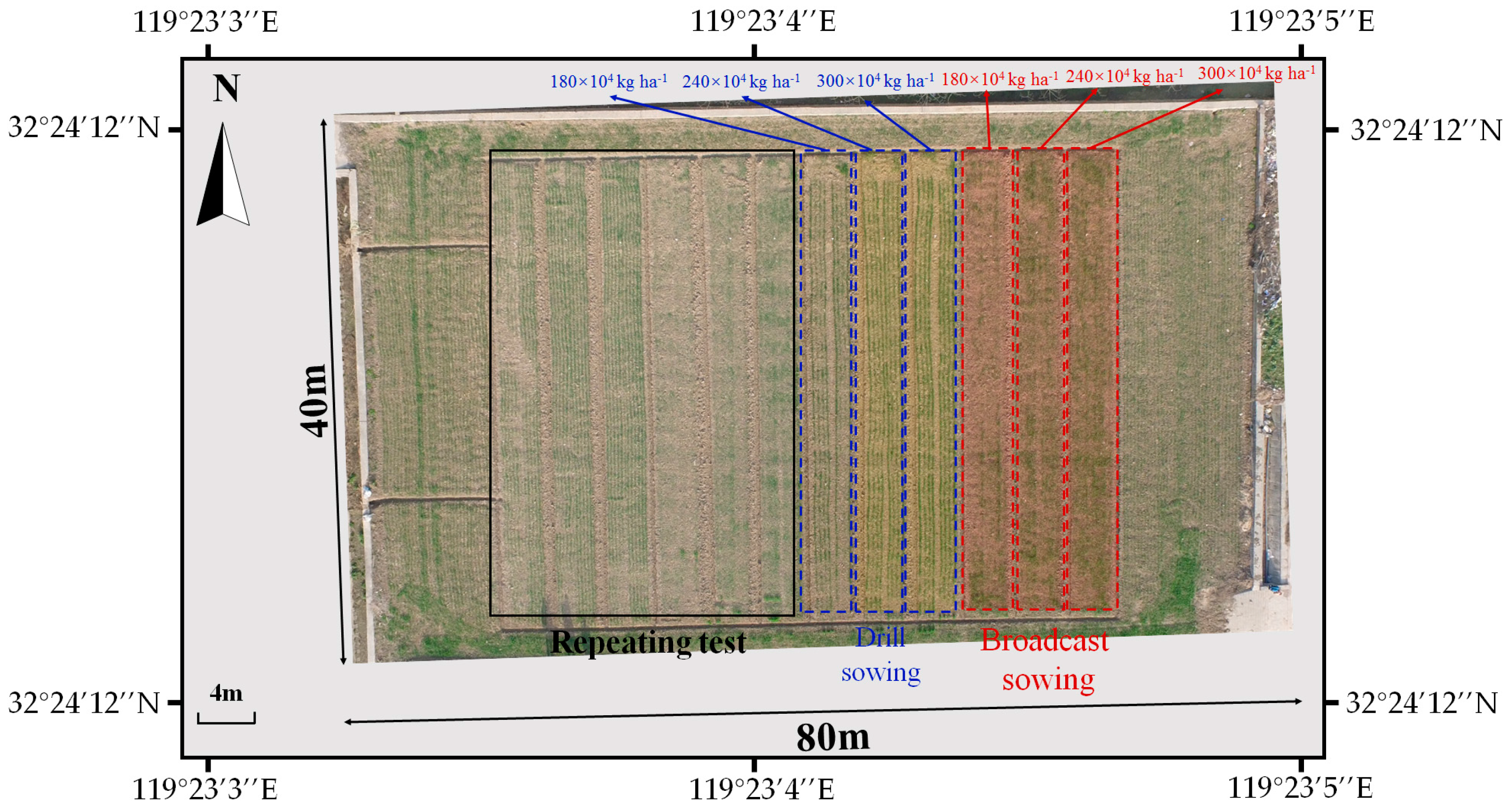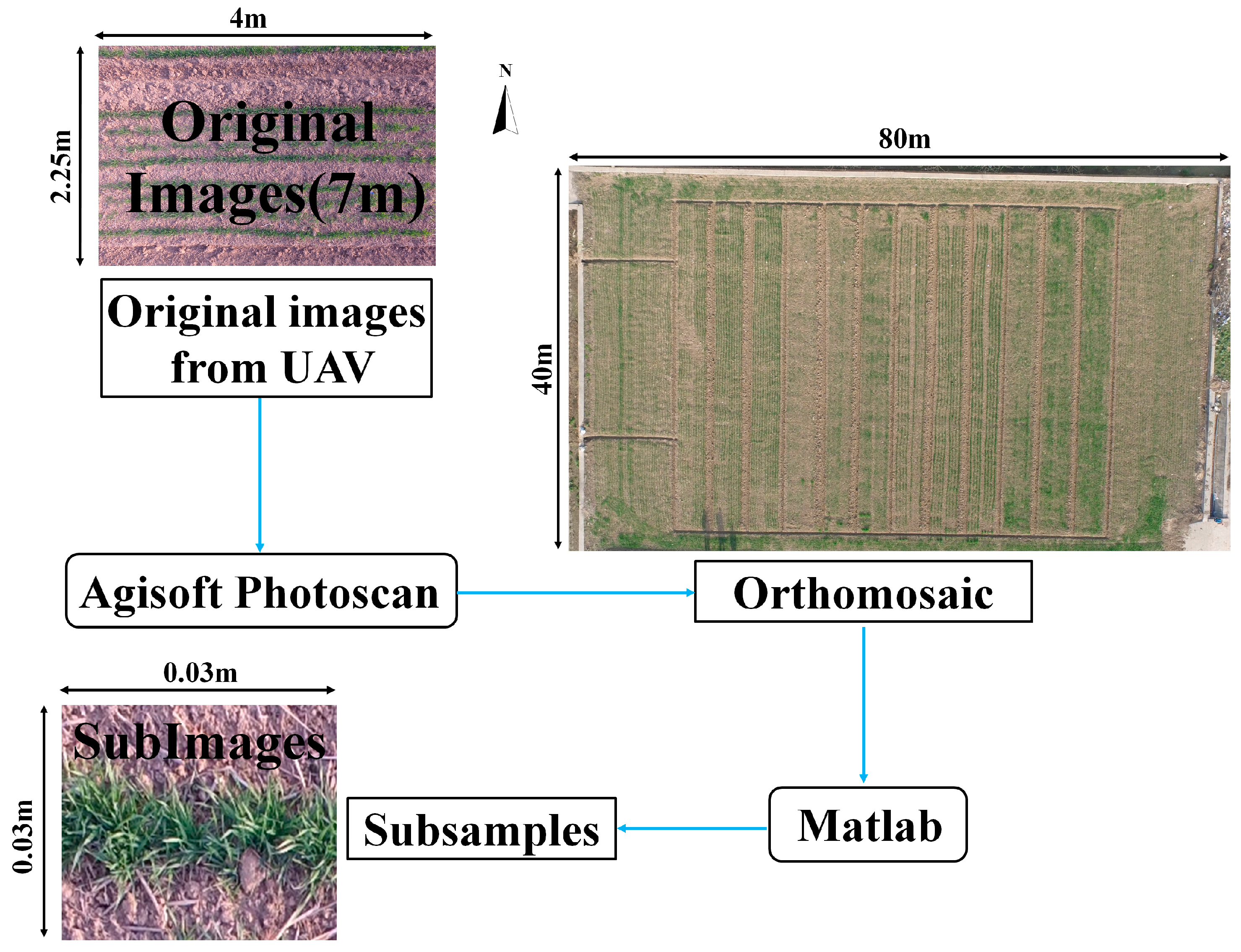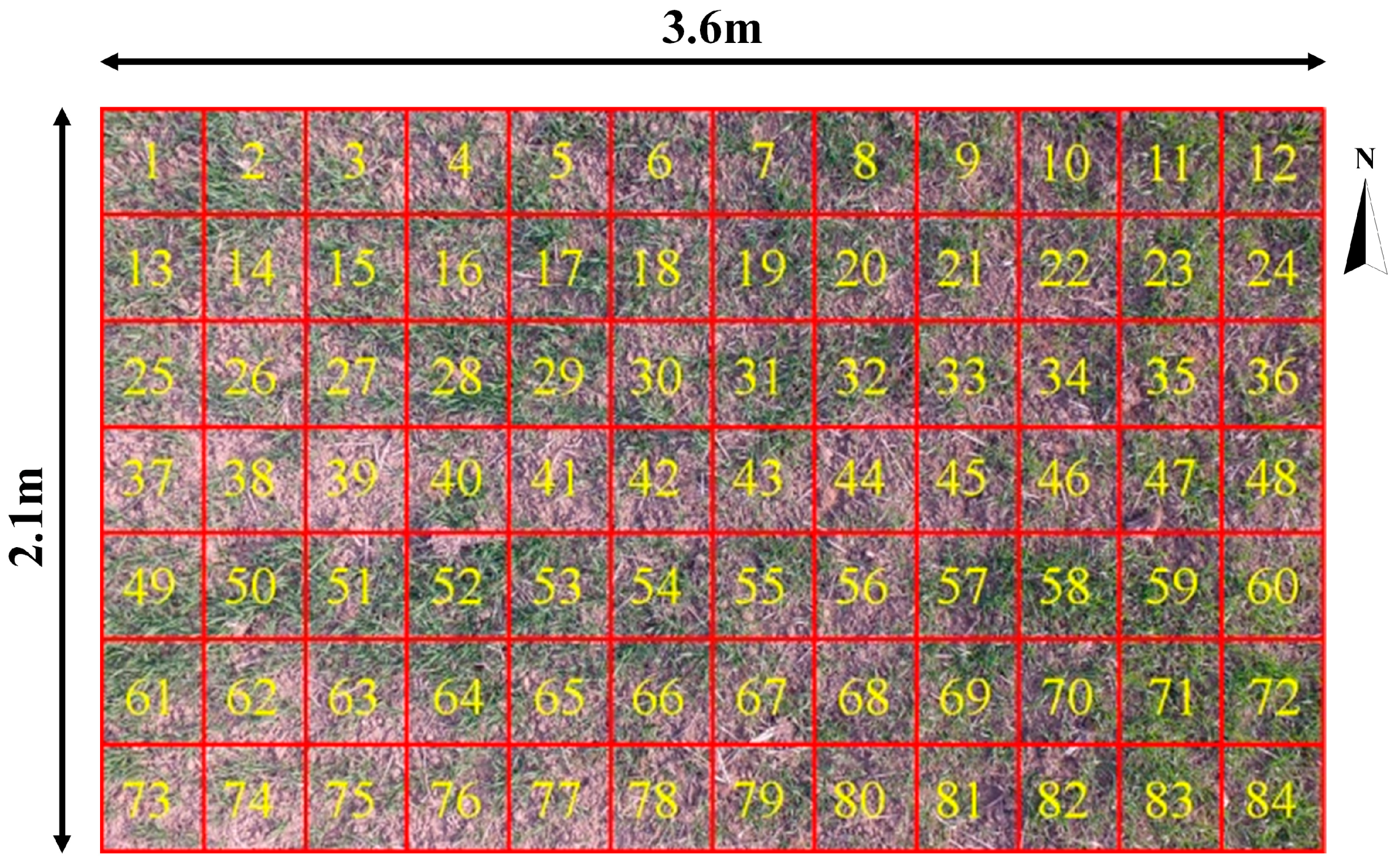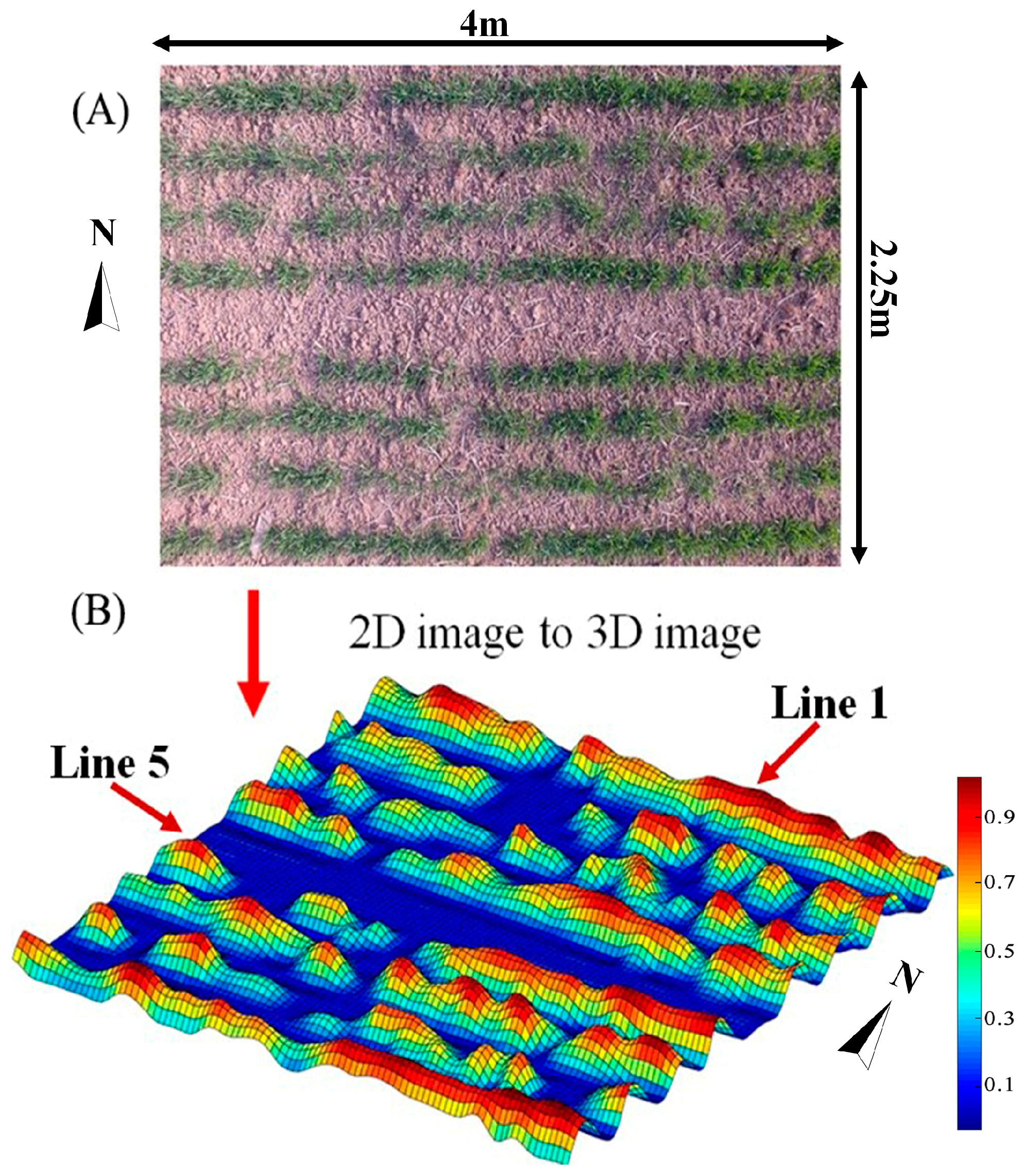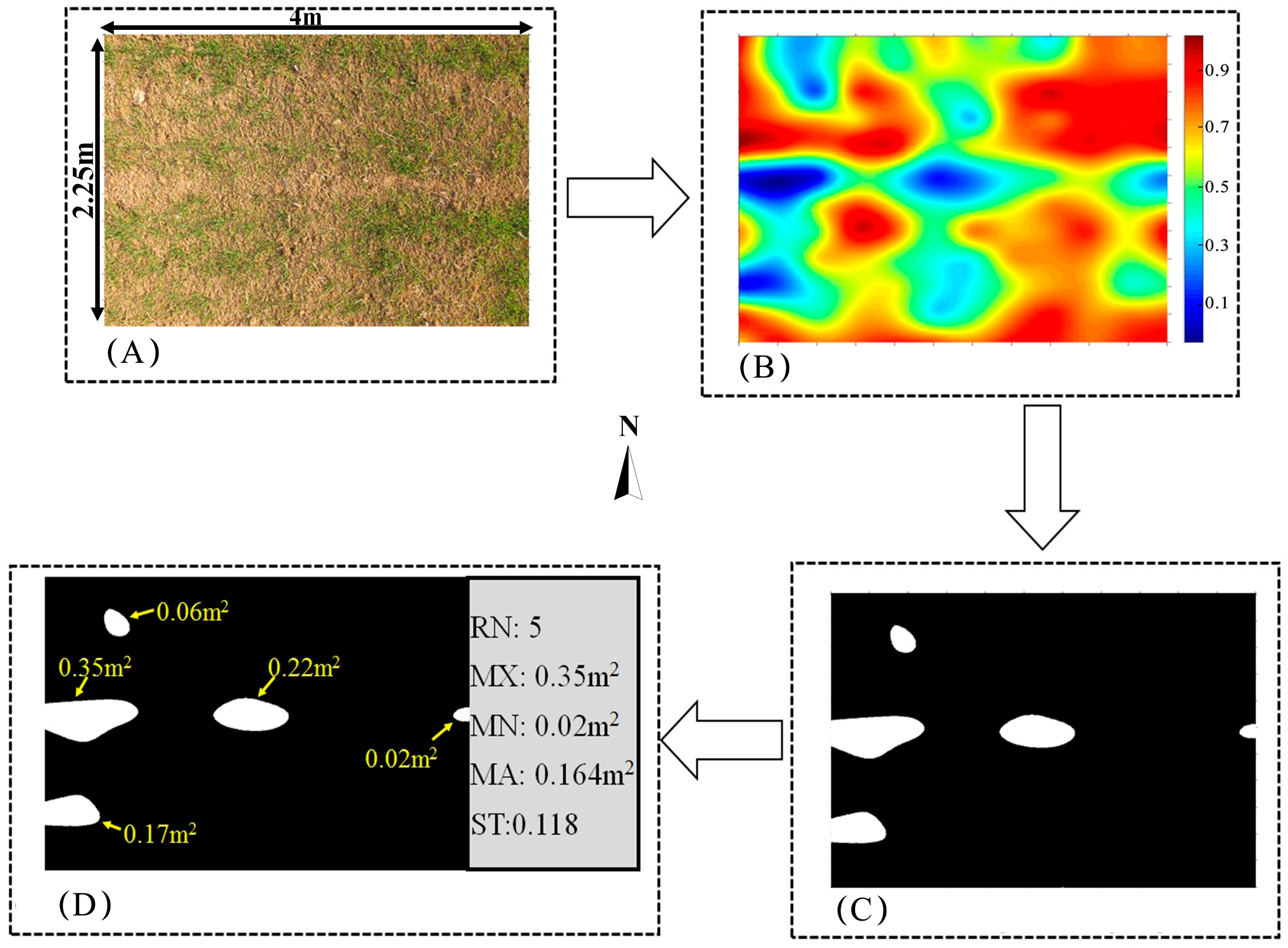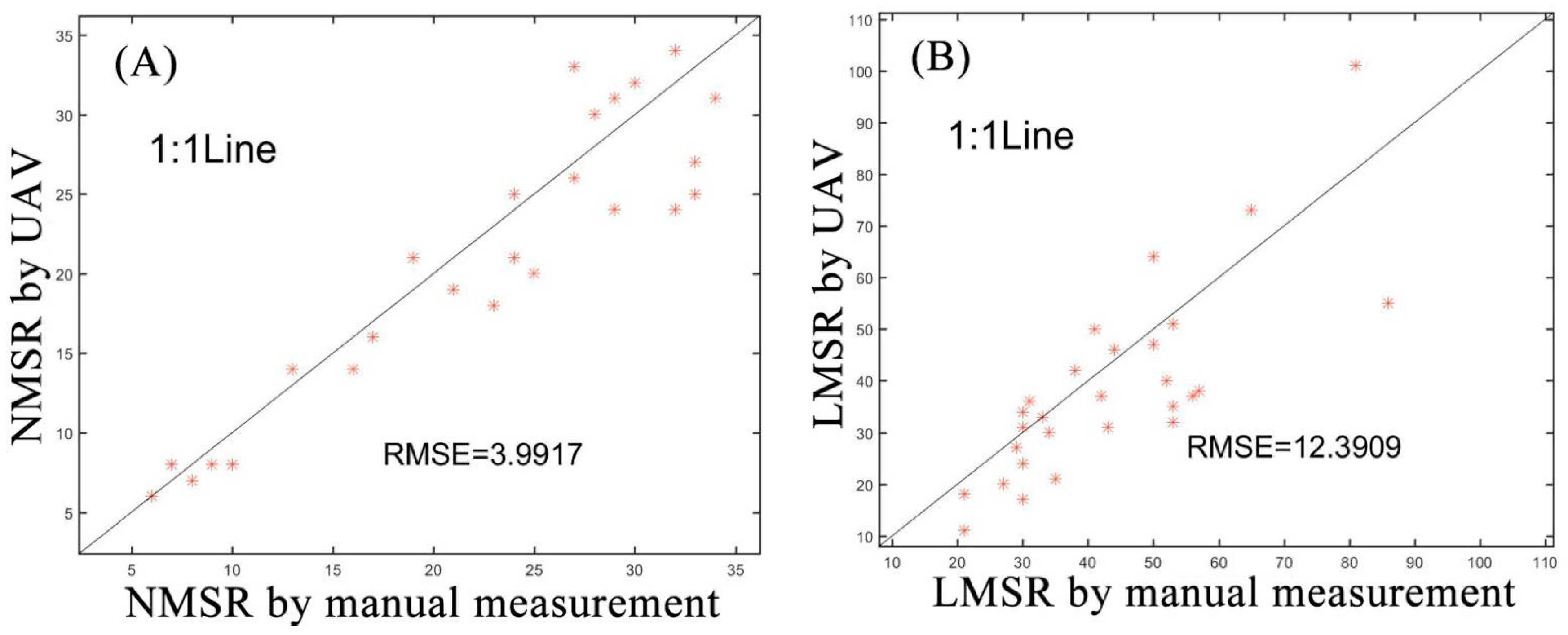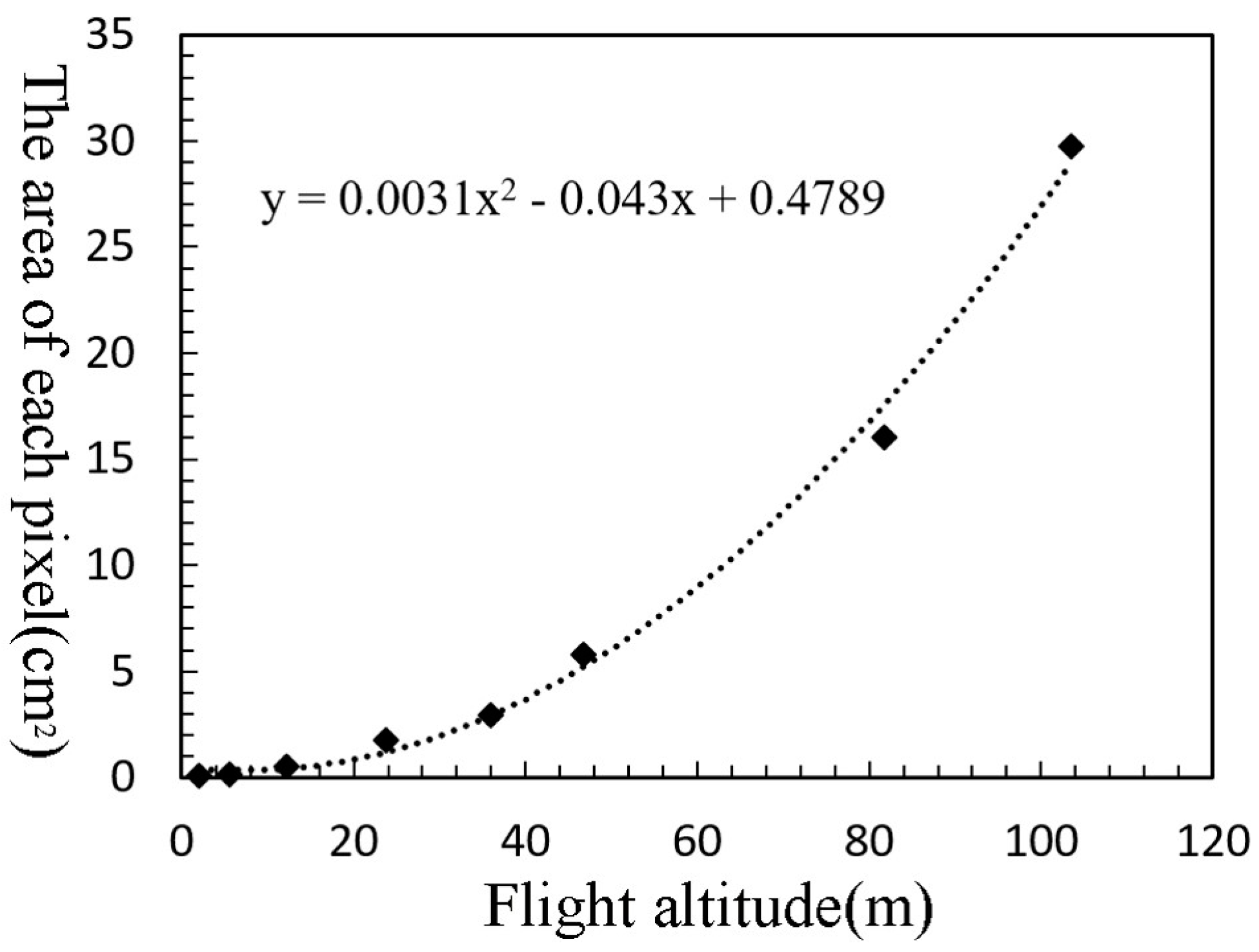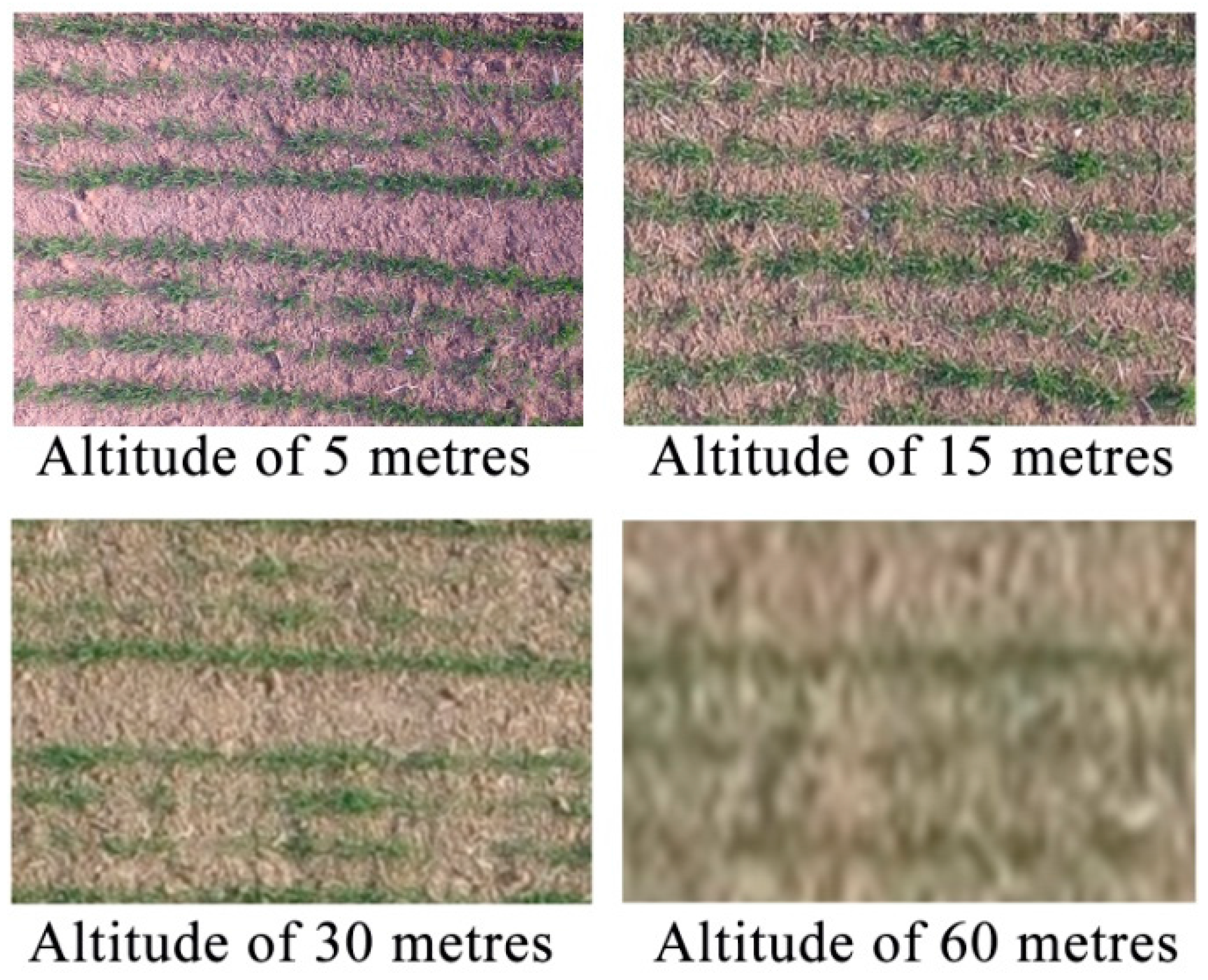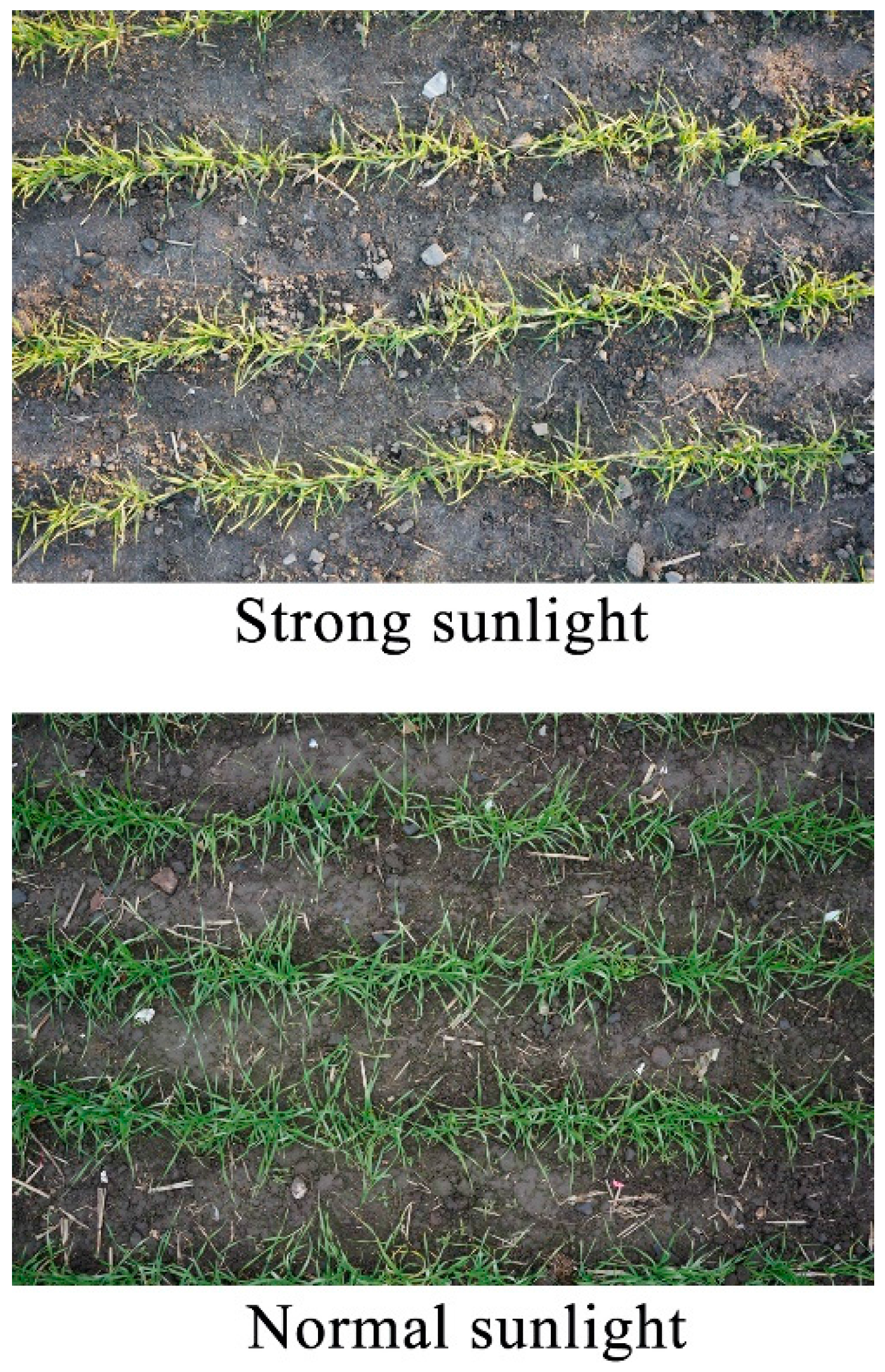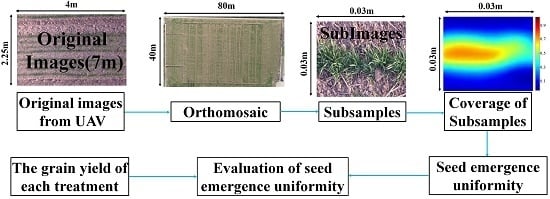1. Introduction
Wheat seedlings grown under non-uniform conditions will result in yield loss. Excessive planting density will reduce the availability of nutrients and intensify intraspecific competition between plants, which will further affect growth and development as well as reduce productivity [
1]. However, while a sparse planting density can ensure full development of individual plants, poor soil fertility and a lack of luminous energy may make it difficult to achieve ideal output, and result in different levels of reduced production. Many factors affect the uniformity of wheat seed emergence. Some problems with seed emergence are also research hotspots, such as the effects of straw mulching [
2,
3], as well as the effects of temperature, moisture and sowing depth [
4,
5]. However, most current research on the uniformity of wheat seed emergence involves manually selecting several regions, investigating the amount of plants in those regions, and calculating the coefficients of variation of the plants in those regions to reflect the uniformity of seed emergence. Such method for measuring the uniformity of seed emergence are time-consuming and laborious as well as inadequate because it cannot directly reflect the seed emergence conditions in a field scale.
Currently, UAV remote sensing is playing an important role in crop monitoring and features high efficiency, high resolution, low cost, low risk, flexibility and other characteristics [
6,
7,
8]. Previous research studies have found that the application of UAV remote sensing is mainly used for crop classification, disaster monitoring, wheat plants density, estimation of agronomic parameters and growth analysis in agricultural applications [
9,
10] In crop classification research, UAVs mainly acquire data on different types of planting areas to facilitate crop management and related decision-making [
11]. Disaster monitoring has been an important topic in recent years, including both the monitoring of field pests and the abnormal growth of crops caused by external factors, such as the monitoring of lodging [
12,
13]. The plants density of wheat was estimated using image processing algorithm and RGB imagery [
14].
The estimation of the agronomic parameters mainly includes growth traits including leaf area index, biomass, nitrogen content and plant height through the establishment of models. Then, researchers looked for UAV image parameters that could reflect the quality of crop population to evaluate the status of crop growth [
15,
16]. Although many applications of UAVs are available related to crop growth and management, few reports were about the application of UAV remote sensing to the evaluation of the uniformity of wheat seed emergence.
This study used UAV images to evaluate the uniformity of wheat seed emergence under the conditions of mechanical broadcast and mechanical drill sowing, to explore the evaluation methods and implementation theories of the study of the uniformity of seed emergence under different sowing patterns. The goal was to provide technical support and a theoretical basis for the comprehensive evaluation of the uniformity of wheat seed emergence.
4. Discussion
The use of UAV image-based data related to the uniformity of wheat seed emergence proposed in this study, to some extent, solved some deficiency problems in terms of manual measurement, but some problems remain and need to be discussed.
4.1. Acquisition Time
The UAV image acquisition time in the wheat growing period may affect the results. Wheat plants at the first and third leaf stage have relatively small leaves (
Figure 10a) so that the UAV images do not provide a clear image of the plants. In addition, some wheat seeds may still have not germinated, so that the use of UAV images at that time provides only relatively partial data related to the uniformity of seedling coverage (
Figure 10b). When wheat reaches the fourth and fifth leaf stage (
Figure 10c), tillering begins to occur, and the region of missing seedlings is more obvious. Therefore, using the coverage of seedlings to evaluate the uniformity of seed emergence in a population is more appropriate (
Figure 10d). By the time the wheat reaches the jointing stage, in some fields the rows will be fully covered by wheat leaves, and the regions with missing seedlings will be hidden by the leaves of other plants (
Figure 10e). The jointing stage loses its usefulness in evaluating the uniformity of seed emergence (
Figure 10f). In summary, the best time to use UAVs for evaluating the uniformity of wheat seed emergence should be around the fifth leaf stage.
4.2. Flight Attitude
A reasonable range of UAV flight height falls between 5 m and 15 m when acquiring images. In the present study, the relationship between UAV image acquisition altitude and actual area of each pixel was demonstrated through standard editing methods (
Figure 11). A low flight height makes it difficult to acquire stable images because the wheat seedlings may sway in the wind, resulting in increased labor to deal with image processing. At the other extreme, a high flight height will lead to the collection of obscure images.
When the UAV flies at an altitude of 5 m, the image is relatively clear and some of the details of the wheat are visible. At 15 m, sporadic regions are fuzzy, but this has smaller impact on the height extraction (
Figure 12). When the flight height reaches 30 m, the image becomes blurred, and the uniformity extraction error is relatively large. Meanwhile, at 60 m, poor image quality makes it impossible to carry out uniformity evaluation.
4.3. Illumination Condition
Weather only slightly affects UAV image acquisition. After collecting the field data, images acquired in the morning or evening with relatively soft light or cloudy weather were available for review. However, particularly strong illumination is unsuitable for data collection because strong light may cause the wheat seedlings to appear white (
Figure 13), making it impossible to completely extract the plants using Equation (1).
4.4. The Component of Field
In terms of field image composition, the fields used in the present study were sprayed with herbicides before the experiment. Therefore, relatively few weeds grew in the field when acquiring the images, and the influence of weeds was ignored during the evaluation of uniformity. Fields with many weeds may be difficult to evaluate using the method proposed in this study. In terms of image processing, the great differences in wheat posture between the broadcast and drill sown patterns presented in the images make it impossible to design a universal method for the extraction of localized regions of missing wheat seedlings and related data. Thus, the methods designed here were unique to the present study.
4.5. The Effect of Emergence Uniformity
The uniformity of wheat seed emergence and the missing seedling rate had certain effects on yield, for the reason that plant density is a key factor influencing grain yield [
14,
20]. However, this effect proved difficult to quantify. Through studying the effects of uniformity and missing seedling rate on the yield, this paper designed an evaluation criterion (
Table 8) for the wheat seed emergence rate, which was formulated based on the range of change of uniformity in the missing seedling rate. Only three stages were classified in this range, namely “good,” “medium” and “bad.” Discovering how to refine the evaluation criteria with the goal of further improving the precision of the evaluation will be the focus of future research studies.
4.6. Comparison to Others
Recent developments in UAV have provided research opportunities in assessing crop growth and physiological traits [
21]. Imagery from UAV coming from different sensors [RGB cameras, multispectral imagery, hyperspectral imagery, and thermal camera] have been used to estimate LAI [
22], biomass [
23], height [
24], nitrogen [
25], and carotenoid [
26]. Most of these studies estimated agronomic parameters by the spectral features of crop. However, some agronomic parameters could not be acquired only using spectral features, such as the information of missing seedling and emergence uniformity. In this case, the geometric and morphological analysis in the proposed method are available. Further, this work could be selected as a reference when the researchers want to use UAV imagery to acquire some agronomic parameters that are difficult to analyze only by spectral features.
